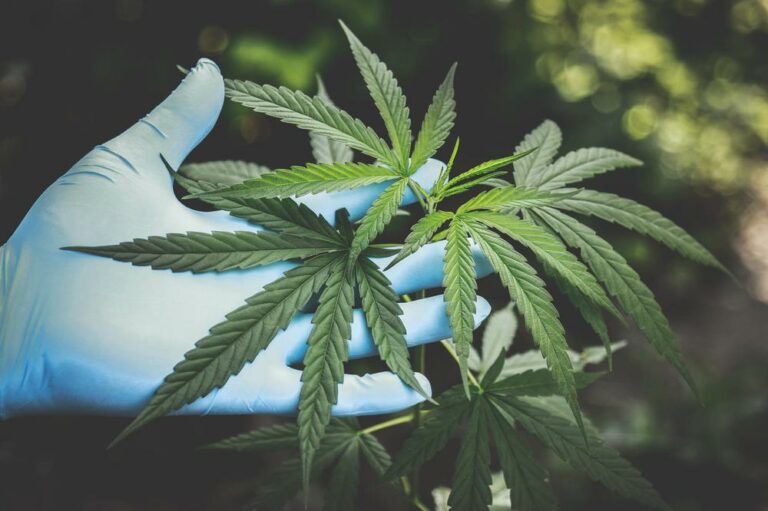 How Can CBD Be Beneficial for Cats?
How Can CBD Be Beneficial for Cats?
- Cannabidiol (CBD) works with the endocannabinoid system (ECS), responsible for regulating bodily functions, such as mood, pain perception, and immune response, in mammals, like cats and humans(1).
- CBD’s potential benefits in cats may be attributed to how the ECS functions similarly in the bodies of mammals, like humans and cats.
- CBD is a compound from Cannabis sativa known to have therapeutic effects in various health issues, like pain, anxiety, and depression(2-3). These illnesses are also common in cats(4-5).
- A 2019 study examined how specific doses of CBD concentration in CBD-rich hemp in pets’ diets affect their blood chemistry. The cats showed lower serum concentrations and behavioral changes, like excessive licking and headshaking(6).
- Only a few studies are available on CBD use in cats. Thus, researchers have yet to prove CBD’s effectiveness in cats.
See the Best CBD Oil for Cats in 2022
Why Cat Owners Are Turning to CBD Oil for Cats
As research showed CBD’s potential benefits in certain conditions, veterinarians and pet owners have also become interested to see if CBD is effective in pets.
A 2019 survey assessed select United States (US) veterinarians’ knowledge, experiences, and perceptions regarding CBD use for canine medical conditions. Most veterinarians agreed with CBD products’ health benefits(7). They also expressed support for the use of CBD products in animals.
However, only 45.5% felt comfortable discussing CBD use with clients. Moreover, veterinarians and clients in states with legalized recreational marijuana and medical marijuana were more likely to talk about using CBD oil products to treat pet ailments than those in other states.
Still, the American Veterinary Medical Association (AVMA) stated that “under current federal and state law, veterinarians may not administer, dispense, prescribe or recommend cannabis or its products for animals”(8).
Human and animal studies have shown CBD’s therapeutic benefits in medical conditions, like pain, anxiety, depression, and inflammation(9-11).
Despite CBD’s increased popularity, available data regarding CBD’s benefits for cats are insufficient. Results of current studies on CBD use in cats also do not look promising.
A 2019 study published in Animals provided a preliminary assessment of the safety and adverse effects of CBD during a 12-week administration using a hemp-based product in healthy dogs and cats(12).
Results revealed that an oral CBD-rich hemp supplement administered every 12 hours was not detrimental.
However, cats seemed to absorb or eliminate CBD differently than dogs. The felines exhibited lower serum concentrations and behavioral changes, such as excessive licking and head shaking upon CBD oil intake.
Other side effects observed include pacing, chomping or chewing, gagging, vomiting food, bile, or hairballs, salivating, and drooling.
Based on these findings, CBD hemp oil products may be safe in healthy adult dogs. However, more research on cats is needed to fully understand CBD absorption and use.
According to the researchers, liver enzyme values should be monitored when using CBD-rich hemp products.
Continued clinical follow up is also necessary for cats undergoing long-term CBD use for naturally occurring diseases. These checkups are also necessary for cats being given CBD alongside other treatments for their ailments.
The researchers added that further studies should examine drug interactions in cats on multiple medications.
While more work is needed to prove CBD’s effectiveness in cats, other cat owners believe in CBD’s benefits for their feline friends based on how CBD works with the ECS.
Mammals, like cats and humans, have the ECS, which is responsible for performing different biological functions, including mood, pain perception, and immune response(13).
The endocannabinoid system has two receptor types, cannabinoid receptors 1 (CB1) and cannabinoid receptors 2 (CB2). They are designed to interact with cannabinoids or compounds, like CBD.
While mammals, like humans and cats, naturally produce cannabinoids called endocannabinoids, others may experience shortage(14).
Thus, administering naturally occurring cannabinoids, like CBD and tetrahydrocannabinol (THC), may help the ECS maintain its function in the body of mammals, such as cats and humans.
How CBD Works to Help Cats
CBD interacts with the ECS, which is present in mammals, like cats and humans. The ECS maintains homeostasis or balance in various bodily functions, such as pain sensation, immune response, anxiety, sleep, mood, appetite, metabolism, and memory(15).
The ECS is composed of CB1 and CB2 receptors located on cells throughout the body.
CB1 receptors lie in the brain and central nervous system, lungs, liver, and kidneys. These receptors play an essential role in memory processing, motor regulation, pain sensation, appetite, mood, and sleep(16). An animal study of these receptors showed that endocannabinoids may attenuate and suppress pain perception(17).
Meanwhile, CB2 receptors lie in cells within the immune system and its associated structures. Once activated, CB2 receptors stimulate a response that helps fight inflammation, reducing pain, and minimizing damage to tissues(18).
The anti-inflammatory effects have potential therapeutic benefits in inflammation-related conditions, such as Crohn’s disease, arthritis, and inflammatory bowel syndrome(19).
Inflammation-related conditions in cats may include osteoarthritis and inflammatory bowel disease(20-21).
CBD vs. Anxiety in Cats
A study published in PLOS One identified separation-related problems in domestic cats. Results revealed common signs of cat anxiety, like destructive behavior and excessive vocalization(22).
Excessive vocalization in cats includes meowing, groaning, howling, or screeching more often than usual.
Behavioral signs also included depression, aggressiveness, and agitation or anxiety.
One of the purported benefits of CBD is its anti-anxiety effects. According to a 2019 study, CBD may reduce anxiety through 5-HT1A serotonin receptor activation(23).
Also called the “happy chemical,” serotonin plays a crucial role in mood, anxiety levels, appetite, and cognitive functions.
Another study highlighted CBD’s potential to trigger the ECS to produce more natural cannabinoids, such as anandamide, responsible for regulating emotions(24).
Moreover, a 2018 review emphasized CBD’s potential anti-anxiety, anti-epileptic, and antipsychotic characteristics that may reduce depression linked to stress(25).
Unlike THC, CBD does not cause users a euphoric high. Also, industrial hemp-derived CBD products containing no more than 0.3% THC are legal at the federal level(26).
Thus, given that CBD is non-addictive and cats have an ECS that works the same way as the ECS of humans and other mammals, CBD may have similar anti-anxiety benefits to cats.
CBD vs. Osteoarthritis in Cats
Osteoarthritis is a degenerative joint condition in which the normal cartilage cushion in the joint breaks down. In cats, the condition causes joint pain, inflammation, and decreased joint movement(27).
Osteoarthritis is prevalent in older cats. It can be actively managed to slow down the course of the disease and preserve the remaining joint function.
However, even experienced veterinarians may find it challenging to conduct physical diagnosis in cats. Generally, cats do not want to be physically handled or manipulated during clinical examinations.
Moreover, unlike dogs, cats can tolerate severe orthopedic diseases given their small size and natural agility.
Thus, veterinarians may find it hard to identify whether a cat is only pulling its foot away because of pain or simply because it does not want to be touched(28).
Studies showed CBD’s potential benefits in treating osteoarthritis symptoms in animals. For instance, a 2017 study in rats examined whether CBD’s anti-inflammatory properties may prevent the development of osteoarthritis pain and joint neuropathy(29).
Results revealed that CBD’s local administration may block the pain and lead to further nerve damage in these joints.
Another study in rats showed that the topical application of CBD may provide therapeutic relief for arthritis pain-related behaviors and inflammation without evident side effects(30).
In a preliminary study conducted on humans, Sativex, a drug with CBD and THC combined, showed benefits in treating pain caused by rheumatoid arthritis(31).
Thus, given that all mammals, including rats, humans, dogs, and cats, have an ECS, CBD’s benefits in cats may be similar.
CBD vs. Cat Coat and Skin Conditions
CBD may also help improve cats’ quality of life by contributing to their coat and skin health. Cats commonly develop atopic dermatitis, an inflammatory and chronic skin condition associated with allergies(32).
Common causes include the feline friends coming into contact with grass, mold spores, and dust mites. CBD may also produce anti-inflammatory effects(33).
Moreover, cats need a healthy diet containing high-quality proteins, carbohydrates, fats, minerals, and vitamins.
Full-spectrum CBD oil consists of a wide range of beneficial compounds, including CBD, low levels of THC, terpenes, flavonoids, and essential oils. It also contains essential vitamins A, D, and E, essential fatty acids, and amino acids that can help protect, repair, and nourish the skin on the scalp.
CBD is also known to have antioxidant properties(34). Antioxidants help keep the hair healthy and shiny and provide protection from ultraviolet exposure(35).
According to a study from the Proceedings of the National Academy of Sciences of the United States of America, CBD, as an antioxidant, was 30%–50% more potent than Vitamins C and E(36).
While the studies above were not specific to cats, CBD’s anti-inflammatory effects and benefits for the hair may also produce the same positive results when used in cats for healthy skin and coat.
The Pros and Cons of CBD Oil for Cats
The Pros
- CBD’s potential health benefits in cats may be linked to CBD’s interaction with the endocannabinoid system, which maintains homeostasis in bodily functions, like pain perception, mood, and immune response(37).
- CBD is known to have therapeutic benefits in several medical conditions, such as pain, anxiety, depression, and inflammation(38-39). These conditions are also commonly diagnosed in cats(40-41).
- Cat owners can choose from various CBD brands. Other companies produce CBD products exclusive to pets.
- The Food and Drug Administration (FDA) allows the use of Epidiolex, which contains a purified form of the drug substance CBD, to help treat seizures from rare cases of epilepsy in children(42). The drug can also be used in an extra–label manner by veterinarians in accord with the Animal Medicinal Drug Use Clarification Act (AMDUCA)(43).
- As of November 2020, the FDA has not directly received any reports of adverse events linked to animals given cannabis products(44). However, there are reports of adverse events from accidental ingestion.
The Cons
- Only a few studies are available regarding CBD use in cats.
- The FDA has not approved cannabis use in animals(45). The agency warns pet owners against using such products and recommends consultation with a veterinarian about appropriate treatment options for pets.
- CBD remains a Schedule 1 controlled substance, according to the Drug Enforcement Administration (DEA)(46). Moreover, according to the AVMA, “under current federal and state law, veterinarians may not administer, dispense, prescribe or recommend cannabis or its products for animals”(47).
- Only the state of California allows veterinarians to discuss cannabis with their clients. As a result, vets lag behind physicians in working with cannabis and researching its use in pets(48).
- Despite CBD’s therapeutic benefits, it has corresponding side effects in cats, such as sedation, polyphagia (extreme hunger), vomiting, and diarrhea(49).
- CBD may interact with other drugs taken by cats, including prescription medicines from veterinarians. These drug interactions may alter the way the body breaks down certain medications(50).
How CBD Oil Compares to Alternative Treatments for Cats
Common alternative treatments for cats include acupuncture, nutraceutical therapy, and massage therapy.
Acupuncture involves stimulating specific points on the body’s surface, usually performed by inserting thin, sterilized stainless steel needles into the spots.
Acupuncture may help treat different disorders, such as arthritis, migraines, back pain, and gastrointestinal and respiratory problems(51).
In veterinary medicine, acupuncture may remedy specific medical conditions commonly related to neurological dysfunction or orthopedic pain(52).
Meanwhile, holistic veterinarians may recommend nutraceutical therapy. This treatment involves the use of nutraceuticals, which are also used as medicine aside from nutrition(53).
Nutraceutics, a term derived from “nutrition” and “pharmaceutics,” is applied to products that are isolated from herbal products, dietary supplements, specific diets, and processed foods used as medicine(54).
A review of human studies indicated that nutraceuticals may help improve health, delay the aging process, prevent chronic diseases, increase life expectancy, or support the body’s structure or function(55).
A 2017 study showed that a nutraceutical diet may help improve clinical symptoms and skin lesions in cats with cutaneous adverse food reaction (CARF)(56).
Other nutraceuticals include CBD as part of the ingredients list. Full-spectrum CBD oils also contain a complete range of cannabinoids, terpenes, flavonoids, essential oils, vitamins, fatty acids, and amino acids.
Terpenes provide cannabis plants’ distinct aroma, while flavonoids give vivid colors to most plants.
Combined, these compounds create a synergistic effect called the “entourage effect,” which may be more effective than the benefits from isolated compounds(57).
Another common alternative treatment for cat diseases is massage therapy. According to an article on massage therapy for cats and dogs, massage has many effects on muscles, the circulatory system, the autonomic nervous system, and the mind(58).
Various massage techniques may help treat several conditions, like swelling and edema, osteoarthritis, and chronic pain.
Meanwhile, CBD massage oils contain CBD oil, which has been shown in studies to provide therapeutic benefits that may also benefit cats.
CBD-infused massage oils hold the same key benefit as other massage oils. CBD oils also have a similar texture to standard massage oils that moisturize the skin without leaving an oily or greasy residue.
Moreover, most CBD massage oils contain other natural ingredients, like coconut oil and jojoba oil.
Full-spectrum CBD oils may also include Omega-3 and Omega-6 fatty acids, which may help regulate blood pressure and inflammatory responses(59).
How to Choose the Best CBD for Cats
CBD, a compound found both in hemp and marijuana plants, is available in different forms: oils, tinctures, gummies, capsules, lotions, creams, and pet treats.
Hemp oil is produced by extracting the oil from hemp. CBD oil comes from the stem, stalk, flowers, and leaves of the hemp plants.
Note that while others may refer to “hemp extract” as hemp oil, the term “hemp oil” should not be confused with “hempseed oil.”
Hempseed oil is derived from hemp seeds. While they are abundant in nutrients, such as omega-3 and omega-6 fatty acids, hemp seeds do not have CBD.
Before purchasing CBD hemp oil products for their furry friends, cat owners should know the different CBD types: full-spectrum, broad-spectrum, and CBD isolates. This knowledge may help identify the right CBD for their pets.
Full-spectrum CBD oil and other products contain a complete range of cannabinoids or compounds, including CBD, THC, terpenes, flavonoids, and other beneficial compounds.
Meanwhile, broad-spectrum CBD is like full-spectrum CBD, except it does not contain the psychoactive compound THC. Thus, broad-spectrum CBD suits those who do not want the risk of experiencing a euphoric high from THC.
CBD isolates are made from pure CBD extracted in isolation from other compounds. While CBD isolates do not produce the entourage effect, they may help cats maximize CBD’s benefits.
Regardless of the CBD type that cat owners choose for their feline friends, they must take the following steps to help them pick the highest quality CBD products:
- Select CBD products that use organic, GMO-free hemp. Reliable CBD companies grow their hemp from their farms or purchase hemp from licensed growers.
- Purchase CBD products that adopt CO2 extraction methods, which use pressurized carbon dioxide to safely extract the purest CBD from plants. Common CBD tincture carrier oils include medium-chain triglyceride (MCT) oil and hempseed oil.
- Choose products with corresponding certificates of analysis (COAs). These are usually available on the brand’s website. The COA should indicate the product’s actual CBD content and absence of pesticides, residual solvents, heavy metals, and other harmful contaminants.
- Compare product label claims with the COA or third-party lab test results. The best CBD oil for cats usually contains an accurate amount of CBD.
- Pick a CBD oil for dogs and cats that does not have unwarranted health claims and provides disclaimers on the brand’s website or product labels.
- Consult a veterinarian knowledgeable in CBD use to determine the right dosage of CBD oil safe for cats to ensure the cat’s health and minimize possible side effects.
CBD Dosage for Cats
CBD dosage for cats can be tricky as it depends on several factors, such as the pet’s age, body weight, diet, and health condition.
Moreover, no official dosage guidelines direct humans and pet owners on how much CBD oil and other products should be administered to address various medical conditions.
This struggle is primarily because the Food and Drug Administration has not yet approved the use of cannabis for animals(60).
Also, different CBD brands provide varying dosing recommendations. When in doubt, err on the side of under-dosing, slowly increasing the dose until the desired effect is achieved.
Gradually introduce any change in brand, CBD to THC ratio, or concentration. Then, re-evaluate the dosing whenever the cat’s health condition changes.
Pet owners should also consider CBD potency when dosing. Several factors affect a CBD product’s potency, like the source of hemp and the extraction method used.
Thus, cat owners must check the product labels and the product’s COA to verify CBD potency.
They should also consult a veterinarian experienced in CBD use to ensure cats’ health and well-being.
How CBD Oil Can Be Given to Cats
CBD oil for cats and other pet products are available in various forms, such as tinctures, cat treats, and cat capsules.
One of the most convenient ways to give CBD oil to cats is through CBD cat tinctures. This CBD format usually comes with a dropper, which allows for easy and accurate dosing.
These tinctures can also be applied sublingually or under the tongue, allowing CBD oil to be absorbed directly into the bloodstream.
Cats can experience results within 30 minutes to 1 hour after use, and the effects may last for 4 to 6 hours.
Cat owners can also add CBD to food or give CBD treats if cats do not like the grassy, earthy taste of CBD oil. Many CBD brands offer CBD treats for cats in different flavors.
Pet owners may sprinkle the contents of CBD capsules into the cat’s food.
Moreover, CBD topicals for cats are available, like CBD massage oils, creams, balms, or salves. Topical application of CBD may help address a cat’s rashes, seasonal allergies, or muscle pain.
Topical CBD products may be applied directly to the cat’s skin, inside its ears, or dabbed on its paws for the cat to lick.
Cat owners are advised to keep a journal or a log of the cat’s CBD dosing, reactions, and behavior. They can share this information with the veterinarian in charge of the cat’s therapy.
Conclusion
The benefits of CBD in cats may be attributed to the compound’s interaction with the ECS, which is present in mammals, like cats and humans.
Several studies have also shown CBD’s health benefits in treating conditions commonly diagnosed in cats.
However, research on CBD use in cats is still lacking. Thus, before using CBD oil for their feline friends, cat owners must consult a veterinarian knowledgeable in cannabis use to ensure their cat’s health and wellness.
- Education Collaboration Hope. (2017, Apr. 18). A Look at the Endocannabinoid System’s CB1 and CB2 Receptors. Retrieved from https://echoconnection.org/look-endocannabinoid-systems-cb1-cb2-receptors/
- Atalay, S., Jarocka-Karpowicz, I., & Skrzydlewska, E. (2019). Antioxidative and Anti-Inflammatory Properties of Cannabidiol. Antioxidants (Basel, Switzerland), 9(1), 21. doi.org/10.3390/antiox9010021. https://www.ncbi.nlm.nih.gov/pmc/articles/PMC7023045/#:~:text=Therefore%2C%20it%20has%20been%20suggested,of%20immune%20cells%20%5B66%5D.
- Corroon, J., & Phillips, J. A. (2018). A Cross-Sectional Study of Cannabidiol Users. Cannabis and cannabinoid research, 3(1), 152–161. doi.org/10.1089/can.2018.0006. https://www.ncbi.nlm.nih.gov/pmc/articles/PMC6043845/#:~:text=Results%3A%20Almost%2062%25%20of%20CBD,reported%20%E2%80%9Cnot%20very%20well.%E2%80%9D
- Mills, D. S., Demontigny-Bédard, I., Gruen, M., Klinck, M. P., McPeake, K. J., Barcelos, A. M., Hewison, L., Van Haevermaet, H., Denenberg, S., Hauser, H., Koch, C., Ballantyne, K., Wilson, C., Mathkari, C. V., Pounder, J., Garcia, E., Darder, P., Fatjó, J., & Levine, E. (2020). Pain and Problem Behavior in Cats and Dogs. Animals: an open access journal from MDPI, 10(2), 318. doi.org/10.3390/ani10020318. https://www.ncbi.nlm.nih.gov/pmc/articles/PMC7071134/
- de Souza Machado, D., Oliveira, P., Machado, J. C., Ceballos, M. C., & Sant’Anna, A. C. (2020). Identification of separation-related problems in domestic cats: A questionnaire survey. PloS one, 15(4), e0230999. doi.org/10.1371/journal.pone.0230999. https://www.ncbi.nlm.nih.gov/pmc/articles/PMC7159185/
- Deabold, K. A., Schwark, W. S., Wolf, L., & Wakshlag, J. J. (2019). Single-Dose Pharmacokinetics and Preliminary Safety Assessment with Use of CBD-Rich Hemp Nutraceutical in Healthy Dogs and Cats. Animals: an open access journal from MDPI, 9(10), 832. doi.org/10.3390/ani9100832. https://www.ncbi.nlm.nih.gov/pmc/articles/PMC6826847/
- Kogan, L., Schoenfeld-Tacher, R., Hellyer, P., & Rishniw, M. (2019). US Veterinarians’ Knowledge, Experience, and Perception Regarding the Use of Cannabidiol for Canine Medical Conditions. Frontiers in veterinary science, 5, 338. doi.org/10.3389/fvets.2018.00338. https://www.ncbi.nlm.nih.gov/pmc/articles/PMC6338022/
- American Kennel Club (2018, Oc. 17). How to Talk to Your Veterinarian About CBD Oil. Retrieved from https://www.akc.org/expert-advice/health/talk-veterinarian-cbd-oil/
- Corroon, J. (2018). Op Cit.
- Atalay, S. (2019). Op Cit.
- Schuelert, N., & McDougall, J. J. (2011). The abnormal cannabidiol analogue O-1602 reduces nociception in a rat model of acute arthritis via the putative cannabinoid receptor GPR55. Neuroscience letters, 500(1), 72–76. doi.org/10.1016/j.neulet.2011.06.004. https://pubmed.ncbi.nlm.nih.gov/21683763/
- Deabold, K. A. (2019). Op Cit.
- Education Collaboration Hope. (2017, Apr. 18). Op Cit.
- Ibid.
- Ibid.
- Ibid.
- Ledent C, Valverde O, Cossu G, Petitet F, Aubert JF, Beslot F, et al. Unresponsiveness to cannabinoids and reduced addictive effects of opiates in CB1 receptor knockout mice. Science. 1999;283:401–4. doi.org/10.1126/science.283.5400.401. https://science.sciencemag.org/content/283/5400/401
- Education Collaboration Hope. (2017, Apr. 18). Op Cit.
- Ibid.
- Cornell University College of Veterinary Medicine. (2018, April). Inflammatory Bowel Disease. Retrieved from https://www.vet.cornell.edu/departments-centers-and-institutes/cornell-feline-health-center/health-information/feline-health-topics/inflammatory-bowel-disease.
- U.S Food & Drug Administration. (2018, Feb. 2). Osteoarthritis in Cats: A More Common Disease Than You Might Expect. Retrieved from https://www.fda.gov/animal-veterinary/animal-health-literacy/osteoarthritis-cats-more-common-disease-you-might-expect#:~:text=Clinical%20signs%20of%20osteoarthritis%20in,jump%20on%20and%20off%20objects
- de Souza Machado, D. (2020). Op Cit.
- De Gregorio, D., McLaughlin, R. J., Posa, L., Ochoa-Sanchez, R., Enns, J., Lopez-Canul, M., Aboud, M., Maione, S., Comai, S., & Gobbi, G. (2019). Cannabidiol modulates serotonergic transmission and reverses both allodynia and anxiety-like behavior in a model of neuropathic pain. Pain, 160(1), 136–150. doi.org/10.1097/j.pain.0000000000001386. https://www.ncbi.nlm.nih.gov/pmc/articles/PMC6319597/
- Leweke, F. M., Piomelli, D., Pahlisch, F., Muhl, D., Gerth, C. W., Hoyer, C., Klosterkötter, J., Hellmich, M., & Koethe, D. (2012). Cannabidiol enhances anandamide signaling and alleviates psychotic symptoms of schizophrenia. Translational psychiatry, 2(3), e94. doi.org/10.1038/tp.2012.15. https://pubmed.ncbi.nlm.nih.gov/22832859/
- Crippa, J. A., Guimarães, F. S., Campos, A. C., & Zuardi, A. W. (2018). Translational Investigation of the Therapeutic Potential of Cannabidiol (CBD): Toward a New Age. Frontiers in immunology, 9, 2009. doi.org/10.3389/fimmu.2018.02009. https://www.ncbi.nlm.nih.gov/pmc/articles/PMC6161644/
- U.S. Food and Drug Administration. (2020, Oct. 1). FDA Regulation of Cannabis and Cannabis-Derived Products, Including Cannabidiol (CBD). Retrieved from https://www.fda.gov/news-events/public-health-focus/fda-regulation-cannabis-and-cannabis-derived-products-including-cannabidiol-cbd
- U.S Food & Drug Administration. (2018, Feb. 2). Osteoarthritis in Cats: A More Common Disease Than You Might Expect. Op Cit.
- Clarke, S. P., & Bennett, D. (2006). Feline osteoarthritis: a prospective study of 28 cases. The Journal of small animal practice, 47(8), 439–445. doi.org/10.1111/j.1748-5827.2006.00143.x. https://pubmed.ncbi.nlm.nih.gov/16911111/
- Philpott, H. T., OʼBrien, M., & McDougall, J. J. (2017). Attenuation of early phase inflammation by cannabidiol prevents pain and nerve damage in rat osteoarthritis. Pain, 158(12), 2442–2451. doi.org/10.1097/j.pain.0000000000001052. https://pubmed.ncbi.nlm.nih.gov/28885454/
- Hammell, D. C., Zhang, L. P., Ma, F., Abshire, S. M., McIlwrath, S. L., Stinchcomb, A. L., & Westlund, K. N. (2016). Transdermal cannabidiol reduces inflammation and pain-related behaviours in a rat model of arthritis. European journal of pain (London, England), 20(6), 936–948. doi.org/10.1002/ejp.818. https://www.ncbi.nlm.nih.gov/pmc/articles/PMC4851925/
- Blake, D. R., Robson, P., Ho, M., Jubb, R. W., & McCabe, C. S. (2006). Preliminary assessment of the efficacy, tolerability and safety of a cannabis-based medicine (Sativex) in the treatment of pain caused by rheumatoid arthritis. Rheumatology (Oxford, England), 45(1), 50–52. doi.org/10.1093/rheumatology/kei183. https://pubmed.ncbi.nlm.nih.gov/16282192/
- Bajwa J. (2018). Atopic dermatitis in cats. The Canadian veterinary journal = La revue veterinaire canadienne, 59(3), 311–313. https://www.ncbi.nlm.nih.gov/pmc/articles/PMC5819051/
- Atalay, S. (2019). Op Cit.
- Ibid.
- Fernández, E., Martínez-Teipel, B., Armengol, R., Barba, C., & Coderch, L. (2012). Efficacy of antioxidants in human hair. Journal of photochemistry and photobiology. B, Biology, 117, 146–156. https://doi.org/10.1016/j.jphotobiol.2012.09.009
- Hampson, A. J., Grimaldi, M., Axelrod, J., & Wink, D. (1998). Cannabidiol and (-)Delta9-tetrahydrocannabinol are neuroprotective antioxidants. Proceedings of the National Academy of Sciences of the United States of America, 95(14), 8268–8273. doi.org/10.1073/pnas.95.14.8268. https://www.pnas.org/content/95/14/8268
- Education Collaboration Hope. (2017, Apr. 18). Op Cit.
- Corroon, J. (2018). Op Cit.
- Atalay, S. (2019). Op Cit.
- Mills, D. S. (2020). Op Cit.
- de Souza Machado, D. (2020). Op Cit.
- U.S. Food and Drug Administration. (2020, Oct. 1). FDA Regulation of Cannabis and Cannabis-Derived Products, Including Cannabidiol (CBD). Op Cit.
- American Veterinary Medical Association. Cannabis use and pets. Retrieved from https://www.avma.org/resources-tools/animal-health-and-welfare/cannabis-use-and-pets
- U.S. Food and Drug Administration. (2020, Oct. 1). FDA Regulation of Cannabis and Cannabis-Derived Products, Including Cannabidiol (CBD). Op Cit.
- Ibid.
- Ibid.
- American Kennel Club (2018, Oc. 17). Op Cit.
- Peachman, RR. (2019, April 11). Should You Try CBD for Your Pet? Retrieved from https://www.consumerreports.org/cbd/should-you-try-cbd-for-your-pet/.
- Kogan, L., Schoenfeld-Tacher, R., Hellyer, P., & Rishniw, M. (2019). US Veterinarians’ Knowledge, Experience, and Perception Regarding the Use of Cannabidiol for Canine Medical Conditions. Op Cit.
- Iffland, K., & Grotenhermen, F. (2017). An Update on Safety and Side Effects of Cannabidiol: A Review of Clinical Data and Relevant Animal Studies. Cannabis and cannabinoid research, 2(1), 139–154. doi.org/10.1089/can.2016.0034. https://www.ncbi.nlm.nih.gov/pmc/articles/PMC5569602/#B1
- Mayo Clinic. Acupuncture. Retrieved from https://www.mayoclinic.org/tests-procedures/acupuncture/about/pac-20392763
- Magden E. R. (2017). Spotlight on acupuncture in laboratory animal medicine. Veterinary medicine (Auckland, N.Z.), 8, 53–58. doi.org/10.2147/VMRR.S125609. https://www.ncbi.nlm.nih.gov/pmc/articles/PMC6042487/
- Nasri, H., Baradaran, A., Shirzad, H., & Rafieian-Kopaei, M. (2014). New concepts in nutraceuticals as alternative for pharmaceuticals. International journal of preventive medicine, 5(12), 1487–1499. https://www.ncbi.nlm.nih.gov/pmc/articles/PMC4336979/
- Kalra E. K. (2003). Nutraceutical–definition and introduction. AAPS pharmSci, 5(3), E25. doi.org/10.1208/ps050325. https://www.ncbi.nlm.nih.gov/pmc/articles/PMC2750935/
- Nasri, H. (2014). Op Cit.
- Mazzeranghi, F., Zanotti, C., Di Cerbo, A., Verstegen, J. P., Cocco, R., Guidetti, G., & Canello, S. (2017). Clinical efficacy of nutraceutical diet for cats with clinical signs of cutaneous adverse food reaction (CAFR). Polish journal of veterinary sciences, 20(2), 269–276. doi.org/10.1515/pjvs-2017-0032. https://pubmed.ncbi.nlm.nih.gov/28865210/
- Russo E. B. (2019). The Case for the Entourage Effect and Conventional Breeding of Clinical Cannabis: No “Strain,” No Gain. Frontiers in plant science, 9, 1969. doi.org/10.3389/fpls.2018.01969. https://www.ncbi.nlm.nih.gov/pmc/articles/PMC6334252/
- Corti L. (2014). Massage therapy for dogs and cats. Topics in companion animal medicine, 29(2), 54–57. doi.org/10.1053/j.tcam.2014.02.001. https://pubmed.ncbi.nlm.nih.gov/25454377/
- EUFIC. (2019, Marc. 27). The importance of omega-3 and omega-6 fatty acids. Retrieved from https://www.eufic.org/en/whats-in-food/article/the-importance-of-omega-3-and-omega-6-fatty-acids#:~:text=Omega%2D3%20and%20omega%2D6%20in%20the%20body,blood%20pressure%20and%20inflammatory%20responses
- U.S. Food and Drug Administration. (2020, Oct. 1). FDA Regulation of Cannabis and Cannabis-Derived Products, Including Cannabidiol (CBD). Op Cit.






















